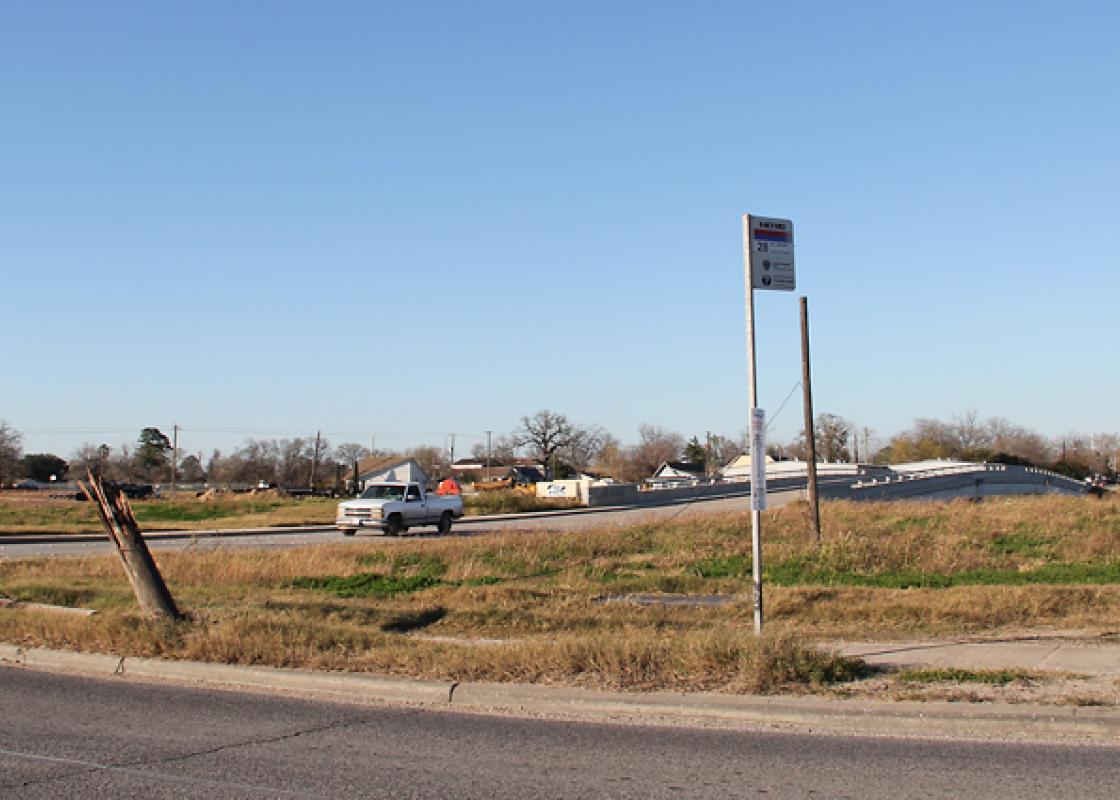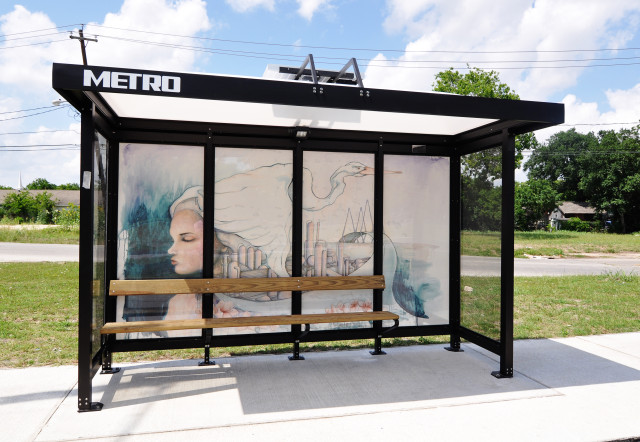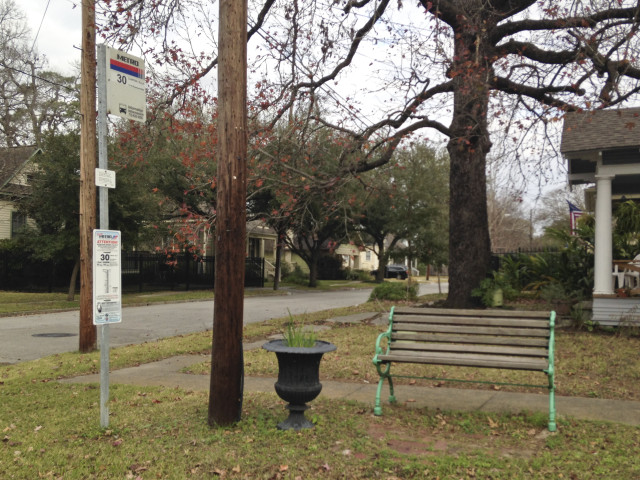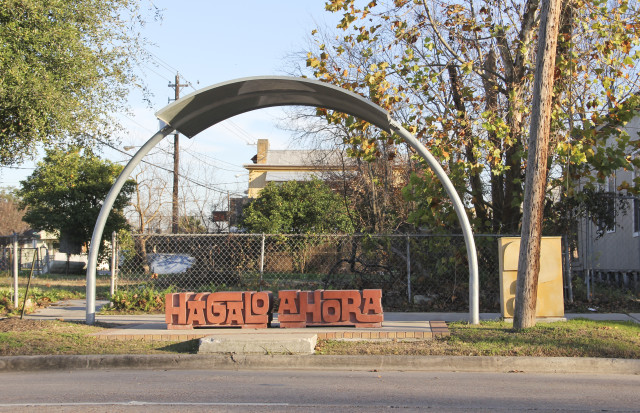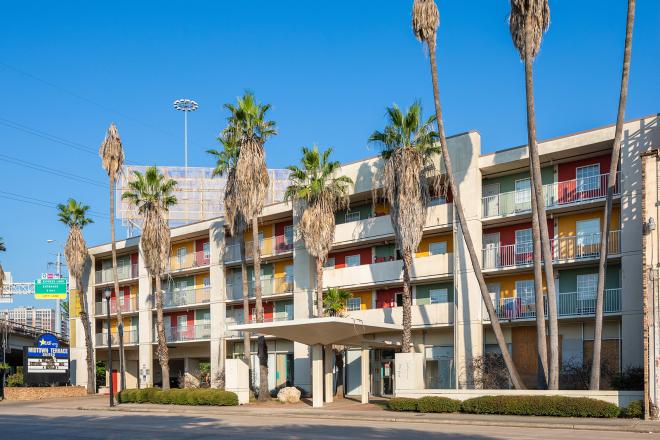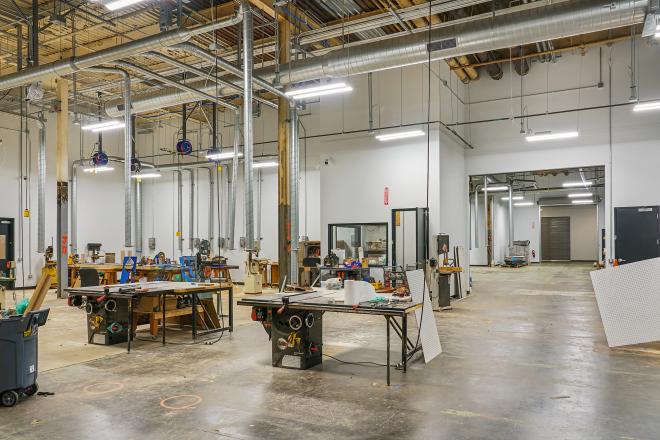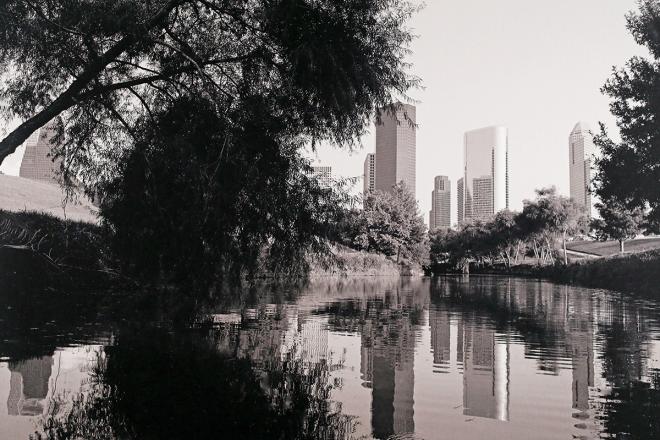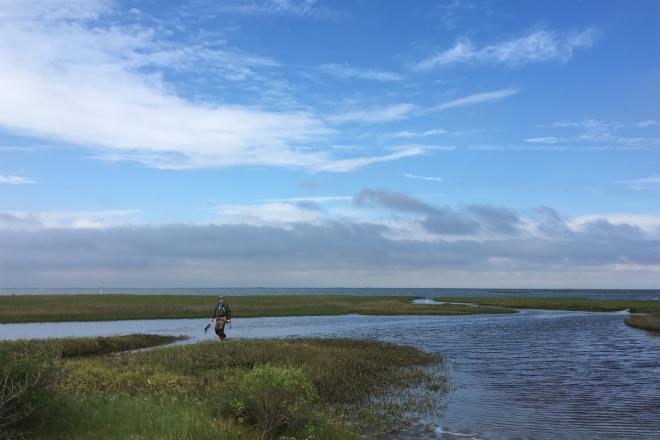Last year, Streetsblog held a contest for its readers to send photos of the “sorriest bus stop” in the country. (The winner — or loser? — was a "stick in the ground" on the shoulder of divided four-lane artery outside St. Louis.) It should be no surprise that Houston, with a bus network comprising 10,000 stops, has its share of sorry ones, too. City of Houston planner Christopher Andrews submitted one on his route. Several of the stops on mine, the 28 Wayside/OST, could have been contenders --- as the photo above illustrates.
Most of Metro’s 10,000 stops are similar to the "stick in the ground" that won the contest --- lacking any protection from the elements and lacking much in the way of aesthetics, too. Though Metro says that it intends to build 100 new shelters every year, only 2,100 of Metro's stops now have shelters, according to Pablo Valle, a program manager for the passenger bus shelter program.
It's a problem some management districts and nonprofits have tried to solve. In Spring 2014, Leadership Houston raised more than $30,000 to pay for four new shelters. Kristi Grizzle, an engineer at Walter P Moore, was part of that Leadership Houston class. “We felt that there was a huge need,” says Grizzle. “New shelters would affect a larger area of Houston [than other potential projects]. Installing them would be helping to increase ridership and promote people using mass transit, instead of their cars.”
As Grizzle points out, shelters do increase ridership --- and have other salutary effects, too. A 2014 study of 822 riders in the Twin Cities by Yinglan Fan of the University of Minnesota found that shelters made wait times feel shorter. For those riders surveyed who waited at a shelter, even a basic one, a five-minute wait seemed more like three. (There are about 12,000 bus stops in the Twin Cities, but as many as 8,000 shelters, 80 of which have heat for their brutal winters.) Additionally, writes Bill Lindeke in response to Fan’s research, “paying attention to design details like ‘next bus’ signage, benches, and other shelter designs can make the buses seem faster, even if the actual bus times don’t change.”
According to Valle, Metro has found that a shelter tends to increase the number of daily riders by about 20. So --- though the new bus network that Metro launched last year created 22 new high-frequency routes, where wait times are less of a concern --- why wouldn't Metro, in hot and humid Houston, where rain often comes in torrents, want to make every stop a shelter?
It's complicated. Shelters are expensive. The cost of the simple structure of a shelter --- three walls and a roof --- is $4,200. A wood bench, a concrete pad for that structure, plus ADA-compliant ramps, curb improvements, signage, trash cans, and storm drains and other flood-control measures, quickly bring the average cost to $15,000 to $20,000.
For another thing, as Valle explains, Metro uses a "point system" to dictate where shelters go. It used to be that the stops that received the most daily boardings would receive a shelter. Now, the stop's context is considered. If the stop is near a school, hospital, retail center, or other "transit generator" like a stadium or grocery store, Valle says, it's given priority. Plus, Metro complies with a federal act that mandates that shelters and other transit amenities be shared equally over the service area. Metro has also responded to neighborhoods' requests to remove shelters when there have been complaints of recurrent drug activity or prostitution --- which shelters can be good at hiding. As a result, some neighborhoods have resorted to a DIY approach:
Other neighborhoods like Upper Kirby, Uptown, Spring Branch, and the Greater East End that have management districts with access to TIRZ funds have built designer shelters that help brand the neighborhood. (These shelters are also maintained independently of Metro.)
The shelters designed and paid for by Leadership Houston are sited on Bissonnet Street at Albacore Drive, Stella Link Road at Cheena Drive, Bellfort Street at Stassen Street, and Brookglade Circle at Dairy Ashford Street. The shelters are likely meaningful to riders in those areas, but Metro, like all other transit agencies, faces a large-scale either/or proposition that Lindeke identifies: can the agency afford to improve service, or add infrastructure?
For Metro, service seems to the priority, as the 2013 decision to abandon plans for a Central Station illustrates; a costly design, the result of a costly design competition won by Snohetta, was shelved in favor of the basic canopy we have today.
Ultimately, the shortage of shelters reflects this city's attitudes about transit. We worry more about how our cars bounce over our potholes than how our streets work on the whole for our public realm. Our sidewalks, narrow as they are in this car-dominant city, buckle and crumble and disappear completely. As Jannette Sadik-Khan, former commissioner of the New York City Department of Transportation, recently told NextCity: "The street is a fundamental operational unit of the city. And each one contains a code for how people should use it. ... But for so many cities, our streets have been in some kind of suspended animation for the last 60 years. The expectation is that our streets are for cars. Car-dominated design has really wreaked havoc on cites."
If there's hope for less car-dominated design in Houston, it's in this city's ability to coordinate across multiple agencies, institutional bodies, sources of funding, and timelines, as the public-private partnerships that have led to spectacular amenities like Discovery Green show. The Houston Bike Plan, for example, is the result of a comprehensive layering of plans, livable center studies, in-process capital improvement projects, and more.
What if Metro were to layer on, too? As certain streets are rebuilt, bike lanes and bus shelters could be incorporated. That would mean better sidewalks for pedestrians, too. Instead of "car-dominant design," we would have infrastructure that supports at least four modes of transportation equally --- as well as the interaction of those modes. More of Houston's public spaces have benefited from this kind of foresight and coordination, but our public transit hasn't. Riding the bus remains less hip than renting a B-cycle, but as more and more people abandon car ownership or seek to supplement it with other mobility options, the least we can do is give them a good place to sit and wait.


